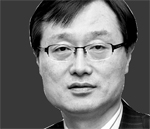Ending the ‘Korea discount’

Kim Kwang-ki
The pundits cite price-earnings ratios, or P/E ratios, and price-to-book values, or P/V ratios, to back up their arguments. The P/E ratio for Korean shares, a comparison of a company’s current share price with its per-share earnings, is at 8.5, sharply below an average of 14 for advanced economies and even the 10.5 average in emerging markets. In terms of the P/V ratio, which is calculated by dividing the closing price of a stock by the latest quarter’s book value, Korean equities are at 1.1, falling below the 1.7 global average. If this relative undervaluation manages to attract investors, Korea’s benchmark index could easily reach 2,200 or 2,300 points, according to the pundits.
Some go as far as to predict the Kospi hitting 3,000 once investors come to their senses and dismiss the “Korea discount” that weighs down local shares. They pin their hopes on the idea that the primary factors to have created the so-called Korea Discount - threats of aggression from North Korea and poor dividend payouts by local companies - may be removed.
It is true that North Korea’s saber rattling and other antics no longer shake the Korean market or have much of an impact on our economy. These days, investors are more likely to be drawn by the siren song of President Park Geun-hye, as she declared earlier this year that unification could bring about a windfall, or a jackpot. Korean shares climbed even when North Koreans fired artillery and rockets near the sea border in the Yellow Sea at the end of March. The so-called North Korea risk is no longer much of a scare.
But the idea that stocks will gain on rosy predictions about unification remains far-fetched. Pyongyang remains stubbornly aloof despite dovish gestures and proposals for renewed exchanges from Seoul. It remains utterly unclear when the inter-Korean economic relationship will wake up from its current comatose state.
There are also hopes that Korean companies will start running their businesses more openly and be more generous with shareholders. The time has come for Korean companies to return some of their profits to shareholders. Among major conglomerates, scions of the third generation are ready to inherit their family empires and can bring with them changes to the old management style. Cash reserves at listed companies are estimated to be at around 200 trillion won ($192.6 billion). Samsung Electronics alone sits on 55 trillion won. Korean companies last year, however, paid out just 12 trillion won in dividends. Dividend returns against stock prices stopped at 1.2 percent, among the bottom in stock markets around the world and just half the global average of 2.4 percent.
It’s not always wise to pay handsome dividends to shareholders. In order for a company to grow, it needs to invest to innovate during profitable times. Technology companies like Microsoft and Apple did not offer any dividends in their early days when they were investing in product development. When businesses reach maturity, they increase dividends. Shareholders won’t leave company managements alone if they do not use their money well. Listed companies in the United States reward shareholders with dividends worth 2.5 percent of their market capitalization and another 2 to 3 percent through repurchase programs. That means U.S. shares deliver 5 percent gains annually.
But Korean companies aren’t ready to raise their dividends to the levels of advanced markets. One Samsung Electronics executive said, “Our company has set a goal to attain a revenue of $400 billion by 2020, and such growth would be the best reward for our shareholders.” He made clear that Samsung Electronics is still strengthening the company and cannot afford to dole out handsome dividends. Other manufacturers like Hyundai Motor and LG Electronics feel the same.
Among midsize groups, old-guard confectionery producers like Lotte, Orion and Namyang tend to be stingy with dividends. Yet some group owners demand fat dividends in the companies they have stakes in. Dam Chul-gon, chairman of Orion Group, received 15 billion won in dividends from an unlisted packaging subcontractor - more than six times the company’s net profit of the year. The confectionery manufacturer paid its shareholders a dividend of a meager 0.3 percent. Individual investors are still the last people Korean business owners think of. They run their businesses like their own kingdoms, with outside directors chosen to act as puppets.
Listed companies are public companies. Once they go public, they no longer belong to select individuals or families but to a mass of shareholders. The Korea discount will come to an end when Korean companies truly go public.
JoongAng Ilbo, April 17, Page 28
*The author is the head of the Economist, a weekly business news magazine published by the JoongAng Ilbo, and the Korean edition of Forbes.
By Kim Kwang-ki










with the Korea JoongAng Daily
To write comments, please log in to one of the accounts.
Standards Board Policy (0/250자)